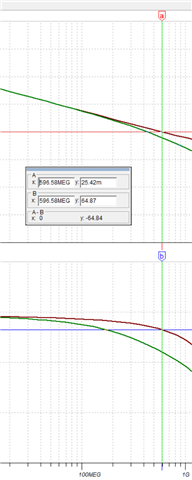Other Parts Discussed in Thread: THS4511, PSPICE-FOR-TI, TINA-TI,
Hello,
I am considering one of the THS451x-SP FDA and was looking through the datasheet. One thing that surprised me is the 348 Ohm RF value without any feedforward capacitance, considering the input capacitance of the input pins (1.5pF CM, 0.5pF DM).
In my head, this places a pole around 500MHz when using the recommended configuration for a gain of +6dB.

I calculate this pole frequency considering the total input capacitance as well as the equivalent resistance seen at this node. If this calculation is correct, this would degrade the phase margin by at least 45 degrees at the crossover frequency, as the crossover frequency is above the pole frequency (3GHz gain-bandwidth product, Signal gain of +6dB).
I decided to use to pspice model to check what was the stability of the model. Surprisingly, the input capacitance of the model seems to be ~10x lower than the one specified in the datasheet, which makes the added pole a non-issue as it becomes above the crossover frequency.
I compared the input characteristics of the FDA (above) with how I interpret the datasheet values for input impedance (below) :

My results are that the pole frequency varies by 10x, indicating that the input capacitance of the model seems to be 10x smaller than my equivalent circuit:

This leads me to the following questions:
- Am I understanding the input impedance values correctly and if so, why does the model not integrate the correct values?
- If my understanding is correct, how does the FDA manage proper phase margin without feedback capacitors to introduce a zero? Does the FDA include any internal compensation, maybe a zero around this frequency to cancel the effect of the pole (I doubt that this is the case, but who knows)?
- What is TI's opinion about using SMALL feedback capacitors to add a zero to improve stability? I mention small values as I know that high speed op amp do not like driving capacitive loads and adding the lead compensator adds capacitance to the output, when considering the input capacitance of the op amp itself.
- Does TI have a SPICE model dedicated to the -SP version? The model is the same as the commercial part, but the CFP packaging must add parasitics that probably matter at those frequencies.
Best regards,
Vincent




